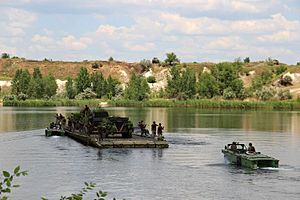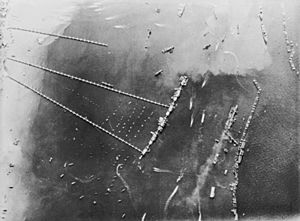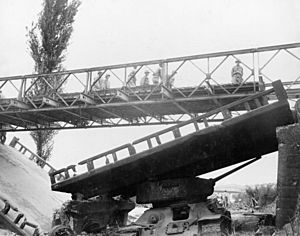Military engineering facts for kids
Military engineering is all about designing and building things for the military. This includes creating military bases, roads, and communication systems. Military engineers also help with the movement of supplies and troops.
In modern times, military engineering also involves protecting against chemical, biological, radiological, and nuclear (CBRN) threats. It also uses other types of engineering, like mechanical and electrical skills.
According to NATO, military engineering is about changing the physical environment to help military operations. This includes supporting troops, protecting forces, dealing with bombs, protecting the environment, and gathering information. It does not include fixing vehicles, planes, or weapons.
Military engineering is taught in special schools called military academies. The people who build and destroy things in military engineering are often called sappers or pioneers. In today's armies, soldiers who do these jobs during battles are called combat engineers.
Sometimes, military engineers also help with non-military projects when there isn't a war. This could be things like controlling floods or helping with river navigation. However, these activities are not part of military engineering itself.
Contents
What is a Military Engineer?
The word engineer first came from warfare. Around the year 1325, an "engine'er" was someone who built or operated military machines. These "engines" were things like catapults used in war.
Later, as people started designing non-military buildings and bridges, the term civil engineering was created. This helped tell the difference between engineers who built for everyday life and those who built for the military. Today, when we say "engineer," we usually mean civil engineers. So, the term "military engineering" is used to be clear about this special type of work.
History of Military Engineering
In ancient times, military engineers were important for siege warfare. They built fortifications, temporary camps, and roads. The Romans and Chinese were famous for their engineering skills. They made huge siege machines like catapults and battering rams.
The Romans built strong, fortified wooden camps and paved roads for their legions. Many of these Roman roads are still used today! The Romans were the first to have a special group of military engineers called architecti. They were amazing at what they did. For example, they built a double wall of fortifications about 30 miles (48 km) long in just six weeks. This was to surround the city of Alesia in 52 B.C.E. This kind of engineering was new and probably very confusing for the Gallic defenders. Vitruvius, a Roman army engineer, wrote about these amazing feats.
Important battles where military engineers played a big role include the Siege of Tyre by Alexander the Great. Also, the Siege of Masada by Lucius Flavius Silva and the Battle of the Trench where a trench was dug to defend a city.
After the Roman Empire fell, military engineering didn't change much for about 600 years. Many Roman techniques were lost. But later in the Middle Ages, military engineering became important again, especially for siege warfare.
Military engineers designed castles and fortresses. When attacking a castle, they planned how to break through its defenses. Sappers were experts at weakening castle walls to create openings. They were skilled at destroying or getting past strong defenses.
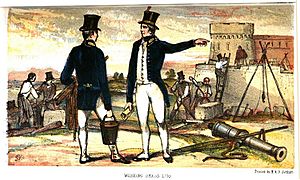
In the 14th century, gunpowder was invented, and new siege engines like cannons appeared. Military engineers were in charge of these new weapons. In England, the Office of Ordnance was created around 1370 to manage cannons and castles. Military engineers and artillery (cannon experts) worked together in this group until 1855.
Cannons were much more powerful than older weapons against medieval forts. So, military engineers had to change how forts were built. New forts were designed to be better protected from cannon fire. They also helped defenders shoot back at attackers more easily. Many forts in 16th-century Europe were built using the trace italienne design, which had star-shaped walls.
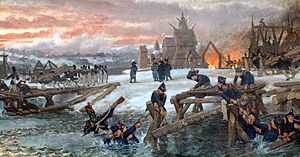
By the 18th century, many armies had special pioneer groups. In peacetime, these specialists built and fixed buildings and wagons. During war, they marched at the front of columns with axes and shovels. They cleared obstacles or built bridges so the main army could move through tough areas. Some modern regiments still have pioneer sections that carry special tools in parades.
The Peninsular War (1808–14) showed that British Army officers and soldiers needed more training in siege operations and building bridges. In 1812, a special school was created to teach "Sapping, Mining, and other Military Fieldworks" to junior officers.
This school, later called "The School of Military Engineering" (SME), became a top place for military engineering training. They held regular exercises, like building a pontoon bridge across the Medway river every year. These events became popular shows for local people. By 1869, the SME was known as a leading scientific military school in Europe.
The invention of the internal combustion engine (like in cars) changed military engineering a lot. With cars and planes in the early 20th century, military engineers had a new job: helping these systems move and be used in war. They also learned a lot about explosives. They were in charge of placing bombs, landmines, and dynamite.
After World War I, the German Army created "Assault Teams" to break through enemy trenches. These teams had special training and weapons like flamethrowers. They had some success, but it was too late to change the war. In early World War II, German "Pioniere" battalions were very effective in attack and defense. This inspired other armies to create their own combat engineer groups. For example, the attack on Fort Eben-Emael in Belgium was done by combat engineers who arrived by glider.
To defeat the German "Atlantic wall" defenses during the D-Day landings in Normandy in 1944, special combat engineer vehicles were developed. These were called Hobart's Funnies. They included the Churchill AVRE, a tank designed to carry combat engineers. These special vehicles were used in Operation Overlord (D-Day).
Other big military engineering projects in World War II include the Mulberry harbour (temporary harbors) and Operation Pluto (underwater fuel pipelines).
Today, military engineering still involves building field fortifications, paving roads, and clearing obstacles. A famous example is when military engineers helped cross the Suez Canal during the Yom Kippur War.
What Military Engineers Study
Military engineers can come from different engineering backgrounds. They might study mechanical, electrical, civil, or industrial engineering.
Types of Military Engineering
Modern military engineering has three main parts:
- Combat engineering: This happens right on the battlefield. Combat engineers help troops move forward by digging trenches and building temporary structures in war zones.
- Strategic support: This involves building things in areas behind the front lines. This includes building airfields and improving ports, roads, and railways for communication.
- Ancillary support: This includes making and giving out maps, and safely getting rid of unexploded bombs.
Military engineers build bases, airfields, roads, bridges, ports, and hospitals. In the past, during peacetime, they often worked on civil projects. But today, military engineers mostly focus on war readiness and logistics (getting supplies and troops where they need to be).
Explosives Engineering
Explosives are substances that produce rapidly expanding gases in a small space very quickly. Military engineers also specialize in explosives and how to use them on the battlefield. Explosive devices have been used for centuries in many operations, from fighting to clearing areas.
The first known explosive, black powder, was developed in 10th-century China. It was first used for fun, but later for military bombs and to launch projectiles from firearms. Military engineers who specialize in this field create and design many explosive devices for different situations. These can range from black powder to modern plastic explosives. This job is often part of what combat engineers do. Their skills also include finding and getting rid of mines and IEDs (Improvised Explosive Devices). For more information, you can look up Bomb disposal.
Military Engineering Around the World
Military engineers are very important in armies all over the world. They are often closely involved in the military's structure and even in combat units.
Brazil
In Brazil, Army engineers can be trained at the Instituto Militar de Engenharia (IME) or the Academia Militar das Agulhas Negras (AMAN). The Navy has engineers in different groups, trained at the Centro de Instrução Almirante Wandenkolk (CIAW) and the Escola Naval (EN). Air Force engineers are trained at the Centro de Instrução e Adaptação da Aeronáutica (CIAAR) and the Instituto Tecnológico de Aeronáutica (ITA).
Russia
 Russian Empire – Pososhniye lyudi
Russian Empire – Pososhniye lyudi Soviet Union – Engineer Troops (Soviet Union); Assault Engineering Brigades
Soviet Union – Engineer Troops (Soviet Union); Assault Engineering Brigades Russia – Russian Engineer Troops
Russia – Russian Engineer Troops
United Kingdom
The Royal School of Military Engineering is the main training center for the British Army's Royal Engineers. This school also trains people from the Royal Navy, Royal Air Force, other parts of the British Army, and other countries. These skills are vital for the Army's operations. Royal Engineers are currently working in many places around the world, including Afghanistan, Iraq, and Cyprus. They also take part in training exercises in countries like Saudi Arabia and the United States.
United States
Military engineering in the United States started during the American Revolutionary War. Engineers in the U.S. Army would map land and build forts to protect troops. The first military engineering group was the Army Corps of Engineers. As the U.S. military grew to include the sea and air, the need for engineers in all branches increased. Each branch developed its own engineering groups and technologies.
- United States Army Corps of Engineers
- Air Force Civil Engineer Support Agency, Rapid Engineer Deployable Heavy Operational Repair Squadron Engineers (RED HORSE), and Prime Base Engineer Emergency Force (Prime BEEF) for the Air Force.
- The United States Navy Construction Battalion Corps (known as the Seabees) and Civil Engineer Corps for the Navy.
- United States Marine Corps Combat Engineer Battalions
Other Nations
 Department of the Engineer Troops of the Armed Forces of Armenia
Department of the Engineer Troops of the Armed Forces of Armenia Royal Australian Engineers and the Royal Australian Air Force Airfield Engineers
Royal Australian Engineers and the Royal Australian Air Force Airfield Engineers Corps of Engineers and Military Engineer Services (MES), Bangladesh Army
Corps of Engineers and Military Engineer Services (MES), Bangladesh Army Canadian Military Engineers
Canadian Military Engineers The Danish military engineering corps is mostly in one regiment, called "Ingeniørregimentet" ("The Engineering Regiment").
The Danish military engineering corps is mostly in one regiment, called "Ingeniørregimentet" ("The Engineering Regiment"). Pioniertruppe (Bundeswehr)
Pioniertruppe (Bundeswehr) Engineering Arm, including the Paris Fire Brigade
Engineering Arm, including the Paris Fire Brigade Indian Army Corps of Engineers
Indian Army Corps of Engineers Indonesian Army Corps of Engineers
Indonesian Army Corps of Engineers Irish Army Engineer Corps
Irish Army Engineer Corps Combat Engineering Corps of the Israel Defense Forces
Combat Engineering Corps of the Israel Defense Forces Engineer Regiment (Namibia)
Engineer Regiment (Namibia) Corps of Royal New Zealand Engineers
Corps of Royal New Zealand Engineers Ingeniørbataljonen ("The Engineer Battalion")
Ingeniørbataljonen ("The Engineer Battalion") Rejimen Askar Jurutera DiRaja ("Royal Engineer Regiment")
Rejimen Askar Jurutera DiRaja ("Royal Engineer Regiment") Pakistan Army Corps of Engineers and the Military Engineering Service
Pakistan Army Corps of Engineers and the Military Engineering Service 10th Engineer Brigade
10th Engineer Brigade South African Army Engineer Formation
South African Army Engineer Formation Sri Lanka Engineers and the Engineer Services Regiment
Sri Lanka Engineers and the Engineer Services Regiment The Le Quy Don Technical University trains the Vietnamese Army's Corps of Engineers.
The Le Quy Don Technical University trains the Vietnamese Army's Corps of Engineers.
See also
 In Spanish: Ingeniería militar para niños
In Spanish: Ingeniería militar para niños
- Bailey bridge
- Fortification
- Military bridges
- Military engineering vehicles
- Siege engine
Famous Military Engineers


